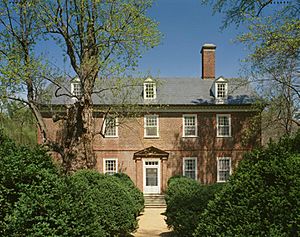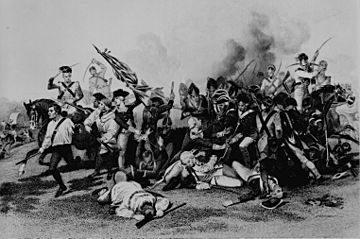Charles Harrison (general) facts for kids
Quick facts for kids
Charles Harrison
|
|
|---|---|
| Born | 1742 Charles City, Virginia |
| Died | 12 December 1793 |
| Allegiance | |
| Service/ |
Artillery |
| Years of service | 1775–1783 |
| Rank | Brevet Brigadier General |
| Battles/wars | American Revolutionary War
|
| Other work | Society of the Cincinnati |
Charles Harrison (born around 1740 – died 12 December 1793) was an important American officer. He was part of the famous Harrison family of Virginia. His brother signed the Declaration of Independence. His nephew, William Henry Harrison, later became a US president.
When the American Revolutionary War began, Charles Harrison joined the army. He started as a lieutenant in an artillery company from Virginia. In 1776, Virginia made its artillery unit bigger. Harrison was put in charge as a colonel. His unit was first called Harrison's Continental Artillery Regiment. Later, it became the 1st Continental Artillery Regiment.
Harrison and his gunners fought in many key battles. He joined George Washington's army at the Battle of Monmouth in 1778. In 1780, he led his artillery at the difficult Battle of Camden. The next year, he commanded the cannons for General Nathanael Greene at the Battle of Hobkirk's Hill.
Charles Harrison's Artillery Regiment
Charles Harrison was born around 1740 in Charles City, Virginia. His parents were Benjamin Harrison IV and Anne Carter. In 1775, Virginia decided to create a state artillery company. This unit included a captain, lieutenants, sergeants, and gunners. Charles Harrison became one of the lieutenants in February 1776. The Second Continental Congress approved this company in March.
In November 1776, Congress allowed Harrison to form a larger regiment. It would have 10 companies, including the two existing Virginia units. This new regiment was sent to the Southern Department. It gathered at Williamsburg, Virginia in 1777. Harrison was made the colonel of this regiment. Edward Carrington became the lieutenant colonel. In March 1778, the regiment was ordered to join the main American army. This army was at Valley Forge, Pennsylvania.
At the Battle of Monmouth on 28 June 1778, Harrison's regiment was part of Henry Knox's artillery. The British commander, Sir Henry Clinton, attacked the American advance guard. But he was stopped by Washington's main army. Clinton tried to break the American left side. However, strong musket fire and effective cannon fire stopped him. This cannon fire came from a group of artillery led by Carrington.
On 10 August 1779, Harrison's regiment was officially renamed. It became the 1st Continental Artillery Regiment. This happened after a review of other artillery units. Harrison's unit was recognized as the first. Later, three Maryland artillery companies joined Harrison's regiment in 1780.
Fighting in the Southern States
In 1780, Edward Carrington took three artillery batteries south. But Charles Harrison arrived and took command because he was senior. The two officers had some disagreements. The new American commander, Horatio Gates, sent Carrington away.
At the Battle of Camden on 16 August 1780, Harrison led 100 artillerists and six cannons. His cannons were placed in the middle of the American lines. An officer named Captain Anthony Singleton saw the British troops close by. He asked for permission to fire. Both sides' cannons fired, creating a thick smoke. When the British attacked, the American militia on the left side ran away. Most of them did not even fire their weapons. The Maryland soldiers fought bravely but were surrounded. They suffered heavy losses. This battle was a terrible defeat for the Americans.
Harrison also commanded General Nathanael Greene's artillery. This was at the Battle of Hobkirk's Hill. He led 40 Virginia gunners and three 6-pound cannons. Before the battle, Greene had sent the cannons away to keep them safe. But the British commander, Lord Rawdon, found out. He advanced to attack on 25 April 1781.
Harrison's cannons rejoined Greene in time for the fight. They were placed in a hidden spot. As Rawdon's attack came closer, Harrison's hidden cannons fired. They used special "case shot" which stopped the British. However, Rawdon was able to stop Greene's counterattack. Three American regiments broke and retreated. But the 5th Virginia Regiment stayed strong and covered the retreat.
The British were about to capture the cannons. Greene sent Captain James Smith and 45 Marylanders to pull them away. They fought off some loyalist dragoons. But Smith was hit, and only 14 men were left. Greene himself helped to drag the three cannons away. Finally, William Washington arrived with about 80 American dragoons. They saved the cannons. The British won the battle, but it didn't help them much. Rawdon soon had to retreat to Charleston, South Carolina.
The 1st Regiment was reorganized in 1780. Its soldiers were sent home for a break in 1783. The regiment was officially ended on 15 November 1783. Charles Harrison left his command on 1 January 1783. Congress honored him with the rank of brevet brigadier general. This was a special honorary rank.
Family Life
Charles Harrison married Mary Claiborne (born 19 January 1744 – died 25 July 1775). They had six children. Their children included Charles II, Mary Herbert, Benjamin Henry, Anne Carter, and Elizabeth Randolph. As mentioned, Charles Harrison was the uncle of President William Henry Harrison. His brother, Benjamin Harrison V, was one of the signers of the Declaration of Independence. Charles Harrison passed away on 12 December 1793.



